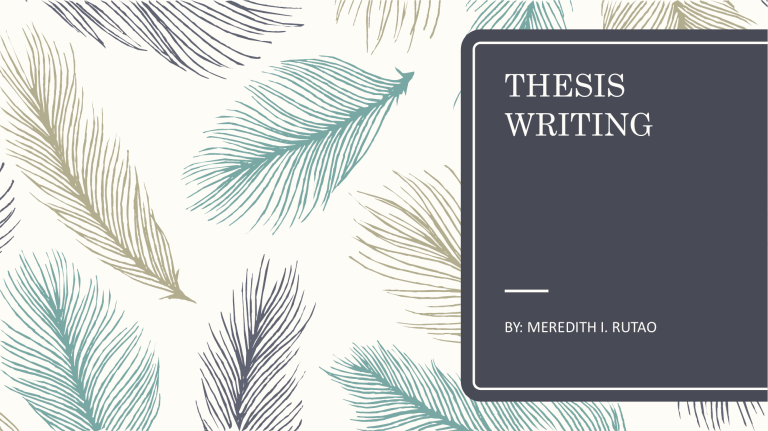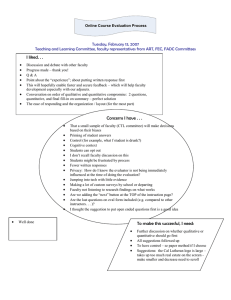THESIS WRITING
advertisement

THESIS WRITING BY: MEREDITH I. RUTAO Thesis Definition – The thesis is one of the most important concepts in college expository writing. A thesis sentence focuses your ideas for the paper; it's your argument or insight or viewpoint crystallized into a sentence or two that gives the reader your main idea. WHAT IS THESIS WRITING? – A thesis statement focuses your ideas into one or two sentences. It should present the topic of your paper and also make a comment about your position in relation to the topic. Your thesis statement should tell your reader what the paper is about and also help guide your writing and keep your argument focused. THREE TYPES OF THESIS – Descriptive research methods are pretty much as they sound — they describe situations. They do not make accurate predictions, and they do not determine cause and effect. There are three main types of descriptive methods: observational methods, case-study methods and survey methods. What approach should I take qualitative or quantitative? – Your approach, research design, and research question are all connected. 'Approach' means something more than the type of data you use – it refers to your overall orientation to research and the type of claims you will make for your study. Dissertations can be based on either quantitative or qualitative data, or on a combination of both. How you choose this may depend on your preferences and abilities, and the suitability of particular approaches to your topic. You need to be able to justify why you have chosen to use such data. Think about the Research Methods modules you have taken so far. Think about the different kinds of studies you have read for other modules. There is plenty of scope to use the approaches and methods that you are most comfortable with. You need to justify your approach and methods and to cite appropriate literature to help you do this. – Quantitative data is particularly useful when you wish to discover how common particular forms of behaviour such as illegal drug use are for a particular age group. – Qualitative data is particularly useful when you wish to find out why people engage in such behaviour. What if I want to find out about social trends, or the measurable effects of particular policies? – You will probably want to use large datasets and undertake quantitative data analysis, and you will be adopting a realist approach to the topic studied. Quantitative dissertations are likely to be nearer to the lower end of the range of approved lengths for the dissertation (e.g. if the length is to be 5,000-8,000 words, dissertations based on quantitative analysis are likely to be closer to 5,000 words in length). They will also include tables and figures giving your important findings. Remember that all tables must be carefully titled and labelled and that sources of your data must be acknowledged. What if I want to record people's views on an issue, and give them a 'voice'? – You will probably want to use in-depth qualitative data, and you may wish to adopt a realist, a phenomenologist, or a constructionist approach to the topic. Qualitative dissertations will include descriptive material, usually extracts from interviews, conversations, documents or field notes, and are therefore likely to be nearer to the upper limit of your word range (e.g. 8,000 words). The types of method suitable for a dissertation could include content analysis, a small scale ethnographic study, small scale in-depth qualitative interviewing. Whether you choose qualitative or quantitative analysis will depend on several things: – Your preferred philosophical approach (realist, phenomenologist or constructionist). – Your skills and abilities with methods of data collection (if needed) and analysis. – The topic or issue you are interested in. – How you frame your research question. Can I combine qualitative and quantitative methods? – There are many ways in which qualitative and quantitative data and analysis can be combined. Here are two examples. – You may be interested in doing an analysis that is primarily quantitative, looking at social trends, or policy implications. However you also want to introduce a 'human touch' by conducting one or several interviews asking what these trends mean to people or how particular individuals experience events. After doing your quantitative analysis, you should include a chapter or section on the qualitative data you have collected. In your discussion of findings you can use the qualitative data to help you understand the patterns in the quantitative analysis. – You may be interested in doing an evaluative case study of a process or policy. You will have a particular focus – a 'case' that you are looking at. You will triangulate methods – i.e. collect data in several different ways, and some of these data may be quantitative. You will analyse each type of data and describe this, and then write a discussion that shows how each piece of analysis contributes to the overall picture of what is going on. WHAT ARE THE TYPES OF RESEARCH METHOD – Quantitative Approaches – There are four main types of quantitative research designs: descriptive, correlational, quasi-experimental and experimental. The differences between the four types primarily relates to the degree the researcher designs for control of the variables in the experiment. Following is a brief description of each type of quantitative research design, as well as chart comparing and contrasting the approaches. – A Descriptive Design seeks to describe the current status of a variable or phenomenon. The researcher does not begin with a hypothesis, but typically develops one after the data is collected. Data collection is mostly observational in nature. – A Correlational Design explores the relationship between variables using statistical analyses. However, it does not look for cause and effect and therefore, is also mostly observational in terms of data collection. – A Quasi-Experimental Design (often referred to as Causal-Comparative) seeks to establish a cause-effect relationship between two or more variables. The researcher does not assign groups and does not manipulate the independent variable. Control groups are identified and exposed to the variable. Results are compared with results from groups not exposed to the variable. – Experimental Designs, often called true experimentation, use the scientific method to establish cause-effect relationship among a group of variables in a research study. Researchers make an effort to control for all variables except the one being manipulated (the independent variable). The effects of the independent variable on the dependent variable are collected and analyzed for a relationship. CHAPTER I – INTRODUCTION – BACKGROUND OF THE STUDY – STATEMENT OF THE PROBLEM – HYPOTHESES – SIGNIFICANCE OF THE STUDY – SCOPE AND LIMITATION OF THE STUDY – CONCEPTUAL FRAMEWORK – RESEARCH PARADIGHM – DEFINITION OF TERMS CHAPTER II – FOREIGN RELATED LITERATURE – FOREIGN RELATED STUDIES – LOCAL RELATED LITERATURE – LOCAL RELATED STUDIES – SYNTHESIS CHAPTER III – METHOD OF RESEARCH – PARTICIPANTS OF THE STUDY – DATA GATHERING – VALIDATION OF THE INSTRUMENTS – STATISTICAL TREATMENT FORMAT – USE FDSA BORDER – ARIAL FRONT – 12 – DOUBLE SPACE EVERY PARAGRAPH – TITLE SHOULD BE CENTER AND BOLD THANKYOU! ADVANCE MERRY CHRISTMAS AND HAVE A FRUITFUL YEAR AHEAD!
